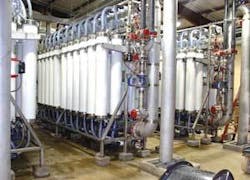Unique joint water district selects ultrafiltration systems
Municipal water and wastewater solutions using ultrafiltration technology help communities meet treatment requirements and save valuable resources.
The Mattapoisett River Valley Water District in the US state of Massachusetts selected ultrafiltration equipment from Koch Membrane Systems (KMS) to treat water for its unique joint water district that will provide potable water to the towns of Mattapoisett, Fairhaven, Marion and Rochester. KMS is based in Wilmington, Massachusetts, USA.
Supported in part by a State Revolving Fund loan, the joint project was developed as an economic solution to provide drinking water to the towns. "Working with Tata & Howard, the district concluded that a regional approach provides a cost-effective alternative for treatment of eight municipal water sources,” said Susan Hunnewell, project manager for Tata & Howard, the engineering firm that is heading the project. “The project promotes the sharing of water resources within the Mattapoisett River Valley by four towns and allows for the reactivation of wells that are currently offline.”
“The selected treatment process of ozone oxidation followed by ultrafiltration has been successfully implemented by Tata & Howard using Koch Membrane Systems ultrafiltration technology in the past,” said Hunnewell. The Mattapoisett plant is the most recent of several ultrafiltration systems supplied by KMS in Massachusetts. The first system, in the Town of Littleton, has been in operation for over eight years, and is still using the original set of membrane cartridges. The ultrafiltration system removes iron and manganese from drinking water.
Four compact HF-56 membrane filtration units, each with 45, 10-inch diameter cartridges, will be installed on site at the end of 2006 to begin operation in early 2007. The membrane filters and equipment will be supplied from eight different well water sources. The system will produce six million gallons per day of filtered water.
The four-unit system consists of low-pressure, polymeric, PMPWTM hollow fiber membrane cartridges mounted on process manifolds, along with the necessary controls, valves, instrumentation, backflush equipment and clean-in-place equipment. The robust PMPW membrane has a small pore size and will act as a barrier to pathogens. Because it will tolerate a wide pH range and is resistant to chlorine, the PMPW membrane is easy to clean. Each unit is frame-mounted, SCADA-compatible and pre-wired, with field connections kept to a minimum. System operation is automated, requiring minimal operator attention.
The PMPW-10 UF cartridge contains 60 percent more membrane area and provides 60 percent more product water than its 8-inch diameter predecessor, resulting in significant cost savings for municipal water treatment plants.
The greater output of the PMPW-10 cartridge results in systems with fewer skids. Plant floor space requirements are reduced up to 50 percent. For new plants, the smaller footprint produces dramatic reductions in building and installation costs. Existing plants can expand capacity by converting from 8-inch cartridges to the PMPW-10 cartridge, without the need for building expansion or new construction.
KMS also announced that it signed another contract for ultrafiltration systems, including PMPW cartridges with BMJ Construction Company, Inc. in Yonkers, New York City, USA. The equipment will help upgrade the Mt. Ebo Wastewater Treatment Plant, located in the Town of Southeast in Putnam County, one hour north of New York City.
Two fully redundant compact membrane filtration package plant systems are installed on site and are ready for start up. The KMS membrane filters and equipment will provide tertiary polishing of effluent from the wastewater treatment plant of a condominium community. Current operation of the Mt. Ebo plant includes primary settling, biological contactors, clarification and gravity sand filtration. Permitted discharge flow from the facility is 160,000 gallons per day.
Membrane filtration and ultraviolet disinfection have been added in the upgrade for removal of turbidity, suspended solids and pathogenic contamination, including Giardia, Cryptosporidium and virus. The membrane system is required to achieve a 3-log removal of Giardia and a turbidity of less than 0.5 NTU.
The plant upgrade will conform to the NYC/DEP Watershed Memorandum of Agreement that provides multi-million dollar project funding to protect the NYC Watershed, in part by upgrading municipal wastewater treatment plants that are operated in watershed communities.
Author’s Note
John McArdle is the director of business development for Koch Membrane Systems, Inc. in Wilmington, Massachusetts, USA, who has more than 20 years of experience in the field of water treatment and separations.

